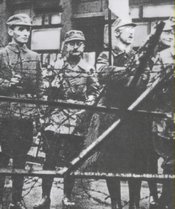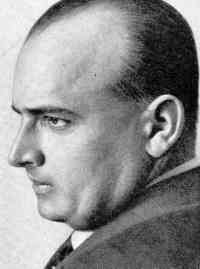Heinrich Himmler
|
|
HeinrichHimmlerColorPortrait.jpg
Heinrich Himmler (October 7, 1900 – May 23, 1945) was the commander of the German Schutzstaffel and one of the most powerful men in Nazi Germany. As Reichsführer-SS, he led the SS, all of its combined offices, and was one of the key figures in the organization of the Holocaust.
| Contents |
Early life
YoungHimmler.jpg
Born near Munich, Bavaria, Germany, into a middle class family, he was the son of a Bavarian schoolmaster and attended Landshut High School. After graduation, Himmler was appointed an Officer Cadet in 1918 and joined the 11th Bavarian Regiment for service in World War I. Shortly before Himmler was due for commissioning as an officer, however, the war ended, and Himmler was discharged from the military without ever seeing combat.
In 1919, a year after World War I had ended, Himmler began studying agronomy at the Technische Hochschule in Munich. During his time as a student, he was an active member of several student clubs. At the same time, he became active in the Freikorps, private armies of right-wing, ex-German Army men resentful of Germany's loss of the First World War. Himmler joined the Reichkriegsflagge (Imperial War Flag) and, in 1923, applied to join the Nazi Party, which were recruiting Freikorps members as potential members of the new Nazi stormtrooper units known as the Sturmabteilung.
Early Nazi Party
In 1923 Himmler was a Feldwebel (Sergeant) in the Reichkriegsflagge, carrying the Imperial German Battle Ensign in the so-called Beer Hall Putsch, the Nazi Party's failed attempt at a revolution in overthrowing the government of Bavaria.
Between 1923 and 1925, with the Nazi party seemingly a failed cause, Himmler devoted himself to other interests, putting his agricultural diploma to work by becoming a poultry farmer. His time as a chicken farmer was unsuccessful, however, and Himmler returned to the refound Nazi Party in late 1926. In 1927 he married Margaret Boden.
The Nazi Party quickly put Himmler to work as the Vice District Leader and Deputy Gauleiter of Upper-Bavaria and also as secretary to Oberste SA-Führer Franz Pfeffer von Salomon. Himmler was subsequently commissioned as an SA-Sturmführer in 1926, and later that year he was appointed an Oberführer, becoming SS-Gauführer (District Leader) in a small SA sub-unit known as the Schutzstaffel or SS. In 1927, Himmler became the vice commander of the SS when he accepted the assignment as Deputy Reich Leader of the SS.
Rise in the SS
HimmlerOberfhr.jpg
Between 1927 and 1929, Himmler devoted himself increasingly to his duties as Deputy-Reichsführer-SS. Upon the resignation of SS Commander Erhard Heiden, Himmler was appointed as the new Reichsführer-SS in January 1929. At the time Himmler was appointed to lead the SS, it numbered only 280 members and was considered a mere battalion of the much larger SA. Himmler himself was only considered an SA-Oberführer, but after 1929 Himmler simply referred to himself as the "Reichsführer-SS".
By 1933, when the Nazi Party rose to power in Germany, Himmler's SS numbered 52,000 members, and the organization had developed strict membership requirements ensuring all members were of Adolf Hitler's "Aryan" "Herrenvolk" (i.e., master race). Now a Gruppenführer in the SA, Himmler next began a massive effort to separate the SS from SA control; he introduced black SS uniforms to replace the SA brown shirts in the fall of 1933. Shortly thereafter, he was promoted to SS-Obergruppenführer und Reichsführer-SS and became an equal to the senior SA commanders, who by this time loathed the SS and the power it held.
Heinrich_Himmler.jpg
Both Himmler and another of Hitler's right hand men, Hermann Göring, agreed the SA and its leader Ernst Röhm were beginning to pose a real threat to the German Army and the whole Nazi leadership of Germany itself. Röhm had strong socialist views and believed that, although Hitler had successfully gained power in Germany, the 'real' revolution had not yet begun, leaving some Nazi leaders believing Röhm was intent on using the SA to administer a coup.
With some persuasion from Himmler and Göring, Hitler began to feel threatened by this prospect and agreed Röhm must die.
Hitler delegated the task of administering Röhm's demise to Himmler and Göring who, along with Reinhard Heydrich, Kurt Daluege and Walter Schellenberg, carried out the execution of Röhm and numerous other senior SA officials in what became known as The Night of the Long Knives on June 30, 1934. The very next day, Himmler's title of Reichsführer-SS became an actual rank, and he was appointed to the position while the SS became an independent organization of the Nazi Party.
Consolidation of power
In 1936, Himmler gained further authority as the SS absorbed all of Germany's local law enforcement agencies into the new Ordnungspolizei, considered a headquarters branch of the SS. Germany's secret police forces were also under Himmler's authority in the presence of the Sicherheitspolizei, which would in 1939 expand into the much larger Reichsicherheitshauptamt. The SS was also developing its military branch, known as the SS-Verfügungstruppe, which would later become known as the Waffen-SS.
Himmler and the Holocaust
After the Night of the Long Knives, the SS-Totenkopfverbände was given the task of organizing and administering Germany's regime of concentration camps and, after 1941, the extermination camps of Poland. The SS, through its intelligence arm the Sicherheitsdienst (SD), was charged with finding Jews, Roma, homosexuals, communists and any other culture or race deemed by the Nazis to be either Untermenschen (sub-human) or in opposition to his regime, and placing them in concentration camps. Himmler now became one of the main architects of the Holocaust, using elements of mysticism and a fanatical belief in the racist Nazi ideology to justify the mass murder and genocide of millions of victims.
The Second World War
In 1944, Himmler was granted still further power as the result of a bitter rivalry between the Sicherheitsdienst (SD) and the Abwehr, the intelligence arm of the Wehrmacht.
The involvement in the July 20, 1944, plot against Hitler of many of the Abwehr leaders, including its head, Admiral Canaris, prompted Hitler to disband the Abwehr and make the SD the sole intelligence service of the Third Reich. This increased Himmler's already considerable personal power.
In late 1944, Himmler became commander of army group Oberrhein (Upper Rhine), which was fighting the oncoming United States 7th Army and French 1st Army in the Alsace region on the west bank of the Rhine. Himmler held this post until early 1945 when he was switched to command an army group facing the Red Army to the East. As Himmler had no practical military experience as a field commander, he was quickly relieved of his field commands and appointed Commander of the Home Army. At the same time, he was appointed as the German Interior Minister and was considered by many to be a candidate to succeed Hitler as the Führer of Germany. However, it became known after the war that Hitler never really considered Himmler as a successor even before his betrayal, believing that the authority that was his as head of the SS had caused him to be so hated that he would be rejected by the Party.
Betrayal, capture, and death
By 1945, Himmler's Waffen-SS numbered 800,000 members, with the Allgemeine-SS (at least on paper) hosting a membership of nearly two million. However, by the spring of 1945 Himmler had lost faith in German victory, probably partially due to his discussions with his masseur Felix Kersten and Walter Schellenberg, and came to the realization that if the Nazi regime was to have any chance of survival, it would need to seek peace with Britain and the United States. Toward this end, he contacted Count Folke Bernadotte of Sweden at Lübeck, near the Danish border, and began negotiations to surrender in the West. Himmler hoped the British and Americans would fight their Russian allies with the remains of the Wehrmacht. When Hitler discovered this, Himmler was declared a traitor and stripped of all his titles and ranks. At the time of Himmler's denouncement, he held the positions of Reich Leader-SS, Chief of the German Police, Reich Commissioner of German Nationhood, Reich Minister of the Interior, Supreme Commander of the Volkssturm, and Supreme Commander of the Home Army.
Unfortunately for Himmler, his negotiations with Count Bernadotte failed. Since he could not return to Berlin, he joined Grand Admiral Karl Doenitz, who by then was commanding all German forces in the West, in nearby Ploen. Somehow, Hitler's orders concerning him never reached Doenitz. After Hitler's death, Himmler joined the short-lived Doenitz government, but was dismissed on May 6, 1945 by its leader in a move he hoped would gain him favor with the Allies.
Himmler next turned to the Americans as a defector, contacting the headquarters of Dwight Eisenhower and proclaiming he would surrender all of Germany to the Allies if he was spared from prosecution as a Nazi leader. In a final example of Himmler's mental state at this point, he sent a personal application to General Eisenhower stating he wished to apply for the position of "Minister of Police" in the post war government of Germany. Eisenhower, however, refused to have anything to do with him, and Himmler was subsequently declared a major war criminal.
Dead_Himmler_1945.jpg
Unwanted by his former colleagues and hunted by the Americans, Himmler wandered for several days around Flensburg near the Danish border, capital of the Doenitz government. Attempting to evade arrest, Himmler disguised himself as a member of the Gendarmerie in the hope that he could return to Bavaria, but was captured on May 22nd in Bremen, Germany, by a British Army unit. In captivity he was soon recognized. Himmler was scheduled to stand trial with other German leaders as a major war criminal at Nuremberg, but committed suicide in Lüneburg by swallowing a cyanide capsule before interrogation could begin. His last words were, "I am Heinrich Himmler!"
Feared by many, but according to Hoehne respected by some of his colleagues, many historians have argued Himmler was more made by those who worked under him rather than by his own designs, although others note how he visited the concentration camps much more frequently than his job would have required, urging the SS men to increased atrocities and personally witnessing many mass shootings—very unlike Hitler, who never visited even one of the camps in his entire career. He was survived by his wife and daughter Gudrun (Burwitz) (b. 1929), who still lives in Germany to this day.
Bibliography
- Höhne, Heinz (1969). The Order of the Death's Head, The Story of Hitler's SS. London: Pan Books Ltd. (1972) ISBN 0330029630




